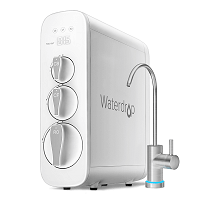There is nothing better than enjoying a refreshing, cold glass of water at the comfort of your home. But did you know that your in-home water filtration system might be putting your health at risk?
The market is saturated with a plethora of options when it comes to servicing the public with pure drinking water. Whether it’s by using tap water, buying potable water or installing a filtration system at-home, many people continue to invest in different alternatives in order to obtain crisp and clean water. One of the most popular alternatives for purifying water at-home are the water filter products. While many people believe water filters provide the cleanest form of water available, many more are unaware of the underlying issues that water filters cultivate as time goes by.
The Function of water Filters
To understand the popularity behind water filters, we must firstly analyze its primary function. One of the main reasons why these filters seem to do their job is because water filters use reverse-osmosis, which is known for being one of the most efficient techniques for filtering drinking water because of its benefits. The filter uses a two-tiered pitcher with a carbon and resin filter within where water is poured through to complete its filtration process. Through this function, water filters are able to reduce the taste and odor of chlorine. It’s also able to remove the following contaminants:
- Copper
- Cadmium
- Mercury
- Zinc
The performance of water filters seem to accommodate the public’s needs for in-home water filtration, if they’re only looking for pure-tasting water. If not, studies have shown that these filters are not necessarily the best alternative to having the purest form of drinking water.
In fact, water filters may actually be contaminating your water supply, meaning that it may not the best water filtration alternative for your home.
The Hidden Build-Up In water Filters
While water claims to purify water by removing dangerous chemicals and metals, there is a major flaw that contributes to the contamination of your water through their filtration system. As concluded by a study from the University of Berkeley on water vs. Tap Water, water filters do not actually kill the microorganisms that may be found in your in-home water supply. In fact, because the filter is not designed to kill bacteria, it becomes a breeding ground for microorganisms, especially if you fail to conduct proper maintenance. As the study states, “An old, unchanged water filter can be dangerous because its use may add bacteria, which had been killed in the tap by chlorine, back into [the filtered] water.”
While water filters provide the taste of moderately filtered water, you would have to accept the fact that an excessive amount of bacteria would be contaminating your water and could become a threat to your body once consumed.
Related Research
Deteriorating water quality from aging infrastructure, growing threat of pollution from industrialization and urbanization, and increasing awareness about waterborne diseases are among the factors driving the surge in worldwide use of point-of-entry (POE) and point-of-use (POU) filters. Any adverse influence of such consumer point-of-use systems on quality of water at the tap remains poorly understood, however. We determined the chemical and microbiological changes in municipal water from the point of entry into the household plumbing system until it leaves from the tap in houses equipped with filters. We show that POE/POU devices can induce significant deterioration of the quality of tap water by functioning as traps and reservoirs for sludge, scale, rust, algae or slime deposits which promote microbial growth and biofilm formation in the household water distribution system. With changes in water pressure and physical or chemical disturbance of the plumbing system, the microorganisms and contaminants may be flushed into the tap water. Such changes in quality of household water carry a potential health risk which calls for some introspection in widespread deployment of POE/POU filters in water distribution systems.
This study shows that POE/POU devices can induce a deterioration of the quality of tap water in Doha. The low bacteria count found in service line water, implies that microbial regrowth in finished desalinated water is insignificant presumably because of very low concentrations of organic matters, minerals, nutrients and the presence of residual disinfectants. By contrast, the CFUs of household and tap water samples were about 12-fold higher that the values for service line water. Equally important, this study documents significant differences in the chemical properties of the tap water compared to the service line water. These results suggest that the installed POE and POU filters and storage tanks have changed the chemical and biological characteristics of household water compared to treated municipal water. The filters also promote microbial growth and biofilm formation in the household water distribution system. The observation that the quality of the water is not exactly maintained from the treatment plant to the consumer’s tap because of the mechanical filters should be a matter of some concern.
Visible sediments in storage tanks and non-sanitary effects of the filters are frequently mentioned as a factor in rejection of tap water by city residents. Analysis of the residues trapped by the filters found no enrichment of toxic metals other than lead. Although the residues may not be a health hazard, they portray a visible esthetic property that can influence the drinking water behavior of many people in Doha. An unintended consequence of the POE/POU systems is the removal of some of the essential minerals and residual disinfecting chlorine used in post-treatment from the water.




